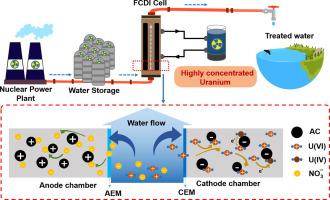Separation and Purification Technology ( IF 8.1 ) Pub Date : 2021-11-22 , DOI: 10.1016/j.seppur.2021.120172 Jian Zhou 1, 2 , Xinyuan Zhang 2, 3 , Yingzi Zhang 1, 2 , De Wang 1, 2 , Hongjian Zhou 2, 3 , Jiaxing Li 1, 2

|
The treatment for large amounts of low concentration radioactive wastewater has always been a worldwide problem, just like the Fukushima nuclear power plant is facing the problem of insufficient storage space. In this work, we have assessed the effectiveness of flow electrode capacitive deionization (FCDI) as a recently developed electrochemical technology to concentrate the radioactive wastewater for the first time. Continuous batch experiments demonstrated that uranium (U) can accumulate into the electrolyte and on activated carbon at the same time in the flow electrode, and the removal efficiency of U remained over 99% during each cycle. Combined with XPS analysis, the migration route and valence change of U in the flow electrode were revealed, which helped to understand the high adsorption capacity of U in FCDI. Long-term batch experiments exhibited that the low concentration of feed water (60 mg L-1 U) could be concentrated by 47 times after 48th continuous cycles, achieving a final concentration of 2843 mg L-1 U in the electrolyte, and 40 mL reduced volume of uranium-containing water from 2,400 mL. Under optimized conditions, a charge efficiency of 86% and a low energy consumption of 2.03 mg J-1 were achieved in 360 mg L-1 initial concentration of UO22+. Overall, high removal rate, excellent concentration effect and low energy consumption make FCDI to be a promising way for radioactive wastewater treatment.
中文翻译:

使用流动电极电容去离子有效浓缩放射性废水中的铀 (VI)
大量低浓度放射性废水的处理一直是世界性难题,就像福岛核电站面临储存空间不足的问题一样。在这项工作中,我们评估了流动电极电容去离子 (FCDI) 作为最近开发的首次浓缩放射性废水的电化学技术的有效性。连续批量实验表明,铀(U)可以同时在流动电极中积累到电解液中和活性炭上,并且在每个循环中U的去除效率保持在99%以上。结合XPS分析,揭示了U在流动电极中的迁移路线和价态变化,有助于了解U在FCDI中的高吸附能力。-1 U) 可以在第 48 次连续循环后浓缩 47 倍,在电解质中达到 2843 mg L -1 U的最终浓度,并将含铀水的体积从 2,400 mL 减少 40 mL。在优化条件下,UO 2 2+初始浓度为360 mg L -1 时,充电效率为86%,能耗低至2.03 mg J -1。总体而言,FCDI去除率高、浓缩效果好、能耗低,是一种很有前景的放射性废水处理方式。


















































 京公网安备 11010802027423号
京公网安备 11010802027423号